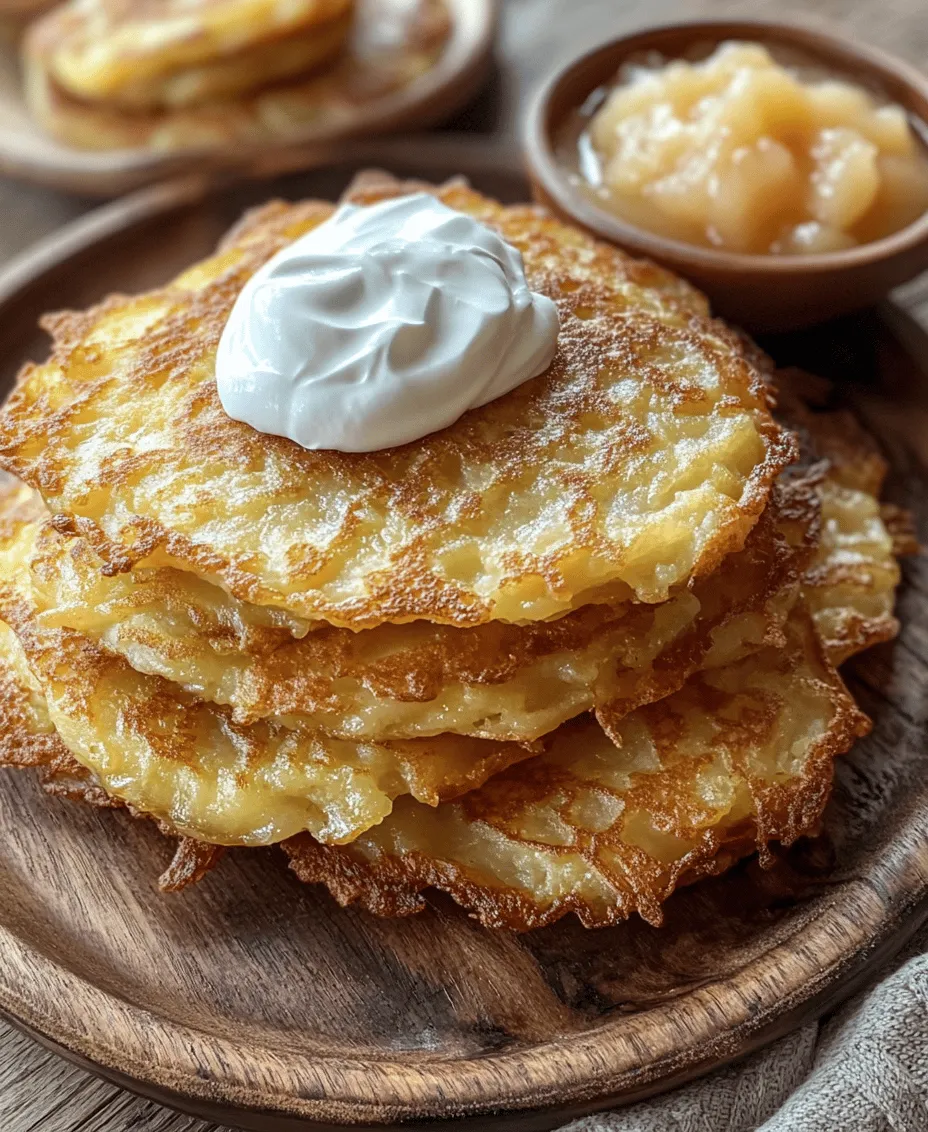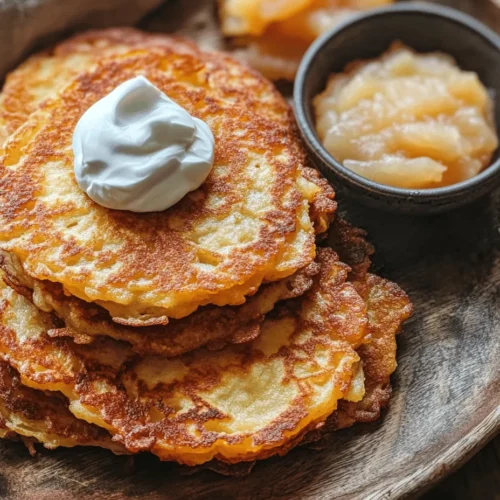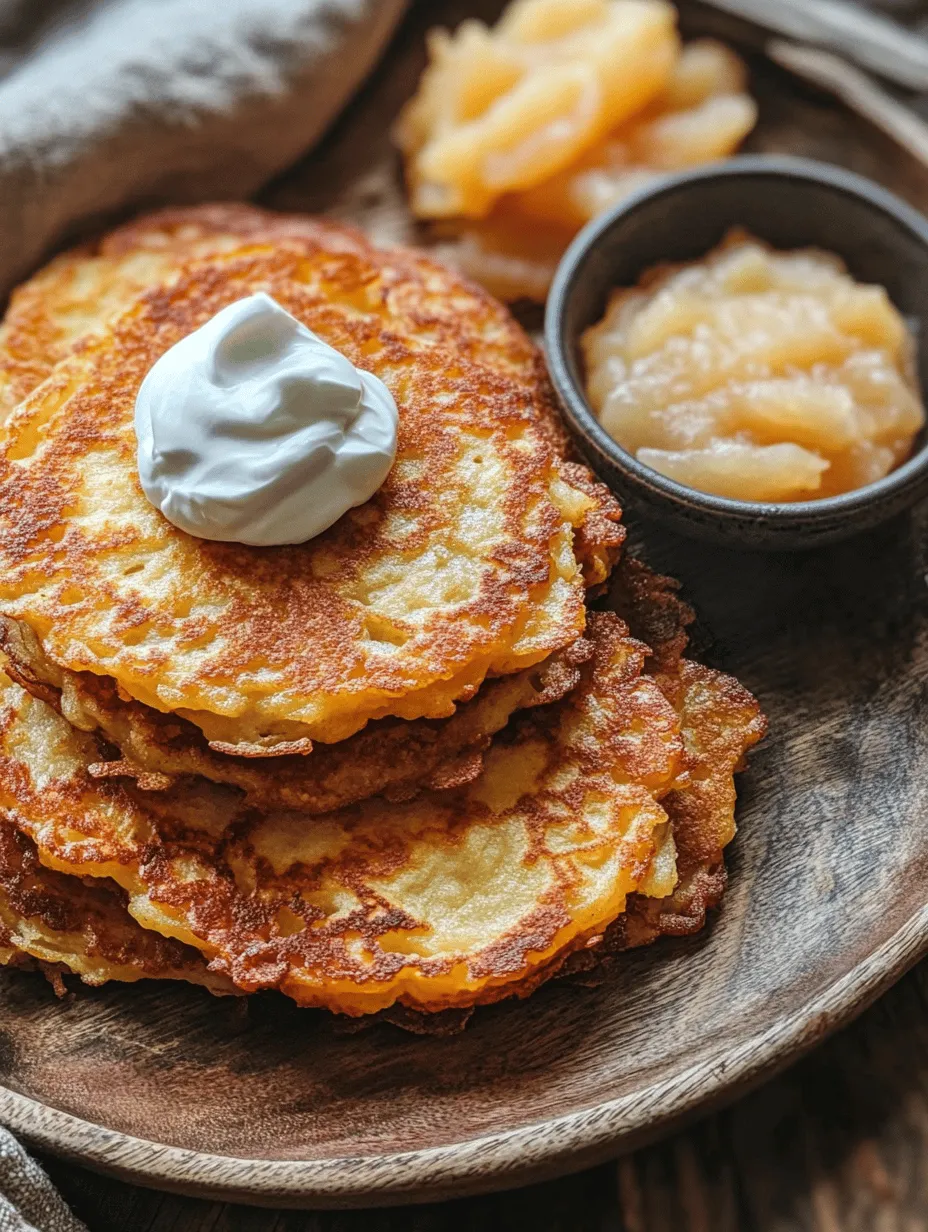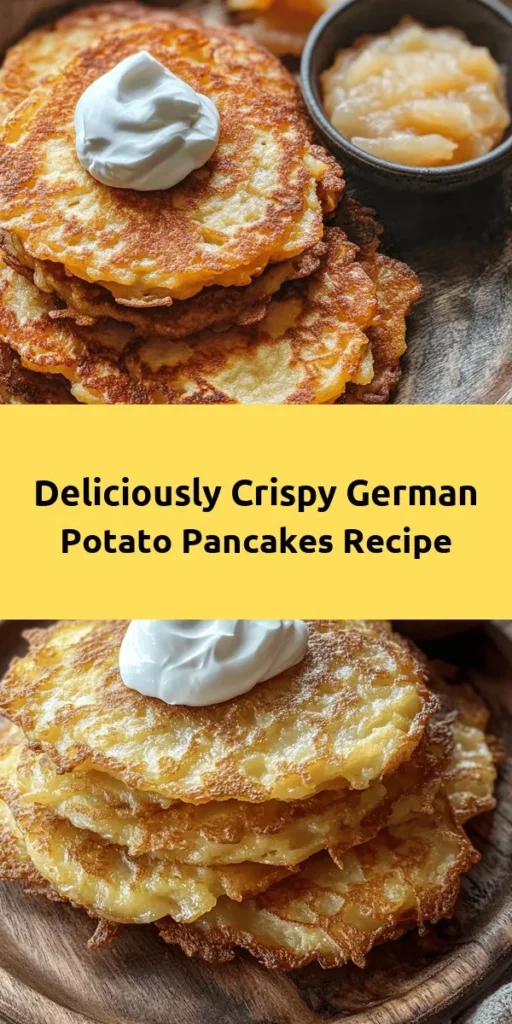Introduction
If you’re on the hunt for a deliciously crispy comfort food, look no further than Kartoffelpuffer, the beloved German potato pancakes. This traditional dish, often enjoyed during festive seasons or as a hearty snack, showcases the humble potato in all its golden, crispy glory. Kartoffelpuffer, also known as Reibekuchen or Kartoffelpfannkuchen in various regions of Germany, have deep-rooted cultural significance that transcends mere sustenance. They evoke memories of family gatherings, holiday markets, and cozy meals enjoyed by the fire.
The charm of Kartoffelpuffer lies not only in their delightful texture and taste but also in the techniques and ingredients that come together to create these golden-brown delights. Authentic Kartoffelpuffer require a careful selection of ingredients and precise cooking methods. By using the right type of potatoes, balancing flavors with seasonings, and understanding the importance of frying techniques, you can achieve the perfect crispy pancake that pays homage to this traditional German recipe.
In this article, we will delve into the essential ingredients that make up Kartoffelpuffer and guide you through a step-by-step process to create this delectable dish in your own kitchen. Whether you plan to serve them as a side dish, topping them with applesauce or sour cream, or simply enjoying them on their own, mastering the art of Kartoffelpuffer is sure to impress family and friends alike.
Understanding the Ingredients
To create the perfect Kartoffelpuffer, it is crucial to understand the role each ingredient plays in achieving that authentic texture and flavor. Let’s break down the key components.
Potatoes: The Heart of Kartoffelpuffer
Potatoes are undoubtedly the star of the show when it comes to Kartoffelpuffer. The type of potatoes you choose can significantly impact the final product. For authentic German potato pancakes, starchy varieties such as Russets or Yukon Golds are recommended. These types of potatoes provide the right balance of starch and moisture, which is essential for achieving a crispy exterior while maintaining a tender inside.
When selecting potatoes, freshness is key. Look for firm, unblemished potatoes that feel heavy for their size. Avoid any that have started to sprout or show signs of decay, as they can negatively affect the flavor and texture of your pancakes. To ensure optimal flavor, consider using locally sourced potatoes if available—freshly harvested potatoes will elevate your Kartoffelpuffer to new heights.
Onion: Adding Depth of Flavor
Onions play a vital role in enhancing the overall taste of Kartoffelpuffer. Their natural sweetness and savory notes complement the starchy potatoes beautifully, adding depth and complexity to the pancakes. For this recipe, a medium-sized yellow onion is typically the best choice, as it strikes a perfect balance between sweetness and sharpness.
When preparing your onion, start by peeling off the skin and cutting it in half. A simple diced or grated preparation will suffice, but finely grating the onion will release its juices and ensure an even distribution throughout the potato mixture. This not only enhances the flavor but also helps in binding the ingredients together.
Eggs and Flour: Binding Agents
Eggs and flour serve as critical binding agents in Kartoffelpuffer, ensuring that the pancakes hold their shape while frying. The egg acts as a natural binder, providing structure and moisture to the mixture. For this recipe, one or two large eggs will typically do the trick.
When it comes to flour, all-purpose flour is the most common choice, but you can experiment with alternatives like potato flour for a gluten-free option. The amount of flour you add can also affect the texture of your pancakes. Too much flour can result in heavy pancakes, while too little might lead to a mixture that falls apart during frying. A good rule of thumb is to start with a small amount and adjust based on the consistency of the mixture—it should be moist but hold together well.
Seasoning: Elevating the Flavor
While Kartoffelpuffer are delicious on their own, seasoning is essential for elevating their flavor profile. Classic seasonings include salt and freshly ground black pepper, which enhance the natural flavors of the potatoes and onions. Some recipes also incorporate garlic powder or nutmeg for an additional layer of flavor.
When seasoning your mixture, it’s important to find the right balance. Remember that the goal is to enhance the dish without overpowering the subtle flavors of the potatoes and onions. A good tip is to start with a small amount of seasoning and taste the mixture before frying a test pancake. Adjust as needed to ensure the flavors are just right.
Frying Fat: Choosing the Right Oil
The choice of frying fat can significantly impact the flavor and crispiness of your Kartoffelpuffer. Traditionally, clarified butter (also known as ghee) is used for frying, as it imparts a rich, nutty flavor while allowing for high-temperature cooking without burning. However, vegetable oil such as canola or sunflower oil is a suitable alternative that can also achieve excellent results.
When frying, make sure your oil is hot enough before adding the potato mixture. This is crucial for achieving that coveted crispy texture. A good test is to drop a small amount of the mixture into the oil; if it sizzles and bubbles, you’re ready to start frying.
Step-by-Step Guide to Making Kartoffelpuffer
Now that you understand the ingredients that make up the authentic Kartoffelpuffer, let’s dive into the step-by-step process of preparing these delicious potato pancakes.
Preparation: Getting Ready to Cook
Before you start cooking, it’s essential to prepare your ingredients properly. Begin by peeling your potatoes—approximately four medium-sized ones should suffice for a generous batch. Once peeled, it’s crucial to soak the potatoes in cold water for about 30 minutes. This step serves two purposes: it prevents the potatoes from browning and helps to remove excess starch, which can lead to gummy pancakes.
After soaking, drain the potatoes and pat them dry with a clean kitchen towel. This will help ensure a crispier end product by reducing moisture in the mixture.
Grating: The Key to Crispy Pancakes
Once your potatoes are prepped, it’s time to grate them along with the onion. The grating process is vital for achieving the right texture in your Kartoffelpuffer. You can either use a box grater or a food processor with a grating attachment. If using a box grater, opt for the largest holes to create shreds that are not too fine, as this will help maintain some texture in the pancakes.
For best results, grate the onion just before mixing it with the potatoes to keep its flavor fresh. Combine the grated potatoes and onion in a large mixing bowl. At this point, you can also add the eggs, flour, and your chosen seasonings. Mix everything together until well combined, ensuring that the ingredients are evenly distributed.
One critical step to achieving crispiness is to remove excess moisture from the mixture. After grating, let the potato-onion mixture sit for a few minutes, allowing any released liquid to pool at the bottom of the bowl. Carefully drain this liquid before adding the binding agents. This will give your Kartoffelpuffer a better chance of achieving that perfect crisp when fried.
With the ingredients prepared and the mixture ready, you are now set to proceed to the frying stage, where the magic really happens. In the next part of this article, we will cover the frying technique and tips for serving your Kartoffelpuffer to ensure they turn out perfectly every time.

Mixing: Achieving the Perfect Batter
To create crispy Kartoffelpuffer, the right batter consistency is crucial. The mixture should be thick enough to hold together but not so dry that it lacks flavor. Follow these step-by-step mixing instructions to achieve the ideal batter for your potato pancakes.
1. Grate the Potatoes: Begin by grating your peeled and rinsed potatoes using a box grater or food processor with a grating attachment. Aim for a medium-coarse texture that will allow the pancakes to maintain some structure while also creating that signature crispy exterior.
2. Remove Excess Moisture: After grating, place the potatoes in a clean kitchen towel or cheesecloth. Squeeze out as much liquid as possible. This step is vital; excess moisture can lead to soggy pancakes that lack the desired crispiness.
3. Combine Ingredients: In a large mixing bowl, combine the grated potatoes with finely chopped onions and your optional ingredients (like garlic). Add eggs, flour, salt, and pepper. Stir until just combined, ensuring that the flour is evenly distributed without overmixing, which can lead to a dense texture.
4. Achieve the Right Consistency: The batter should be moist but firm enough to hold its shape when spooned into the frying pan. If the mixture seems too wet, gradually add a bit more flour until it reaches the desired consistency.
Tips for Achieving the Right Consistency:
– If using starchy potatoes like Russets, you may require less flour due to their moisture content. Conversely, waxy potatoes may need a bit more.
– Avoid using pre-packaged shredded potatoes, as they often contain preservatives and do not yield the same texture.
– For enhanced flavor, consider adding a pinch of nutmeg or smoked paprika to the batter.
Frying: The Art of Cooking Kartoffelpuffer
Frying is where the magic happens, transforming your batter into deliciously crispy Kartoffelpuffer. Here’s a detailed process to ensure perfect frying every time.
1. Heat the Oil: In a large skillet or frying pan, pour in a generous amount of vegetable oil—enough to cover the bottom of the pan by about ¼ inch. Heat over medium-high heat until the oil shimmers but doesn’t smoke. A temperature of around 350°F (175°C) is ideal for frying.
2. Fry in Batches: Using a large spoon or a measuring cup, scoop the batter and gently place it into the hot oil. Avoid overcrowding the pan, as this will lower the oil temperature, leading to greasy pancakes. Fry in batches of three or four, depending on the size of your skillet.
3. Cooking Time: Allow the pancakes to fry for about 4-5 minutes on one side. Look for visual cues: the edges should turn golden brown, and the surface should start to bubble. Once you see these signs, it’s time to flip.
4. Flipping the Pancakes: Carefully turn each pancake using a spatula. Fry the other side for an additional 4-5 minutes until it’s equally golden and crispy.
5. Draining Excess Oil: Once cooked, transfer the pancakes to a plate lined with paper towels to absorb any excess oil. This step is essential for achieving that desired crispness.
Serving: Traditional Accompaniments
The beauty of Kartoffelpuffer lies not only in their crispy texture but also in how they are served. Traditionally, these potato pancakes are accompanied by a variety of toppings that enhance their flavor.
1. Applesauce: A classic pairing, applesauce offers a sweet and tangy contrast that complements the savory pancakes. The smooth texture of the applesauce balances the crunchiness of the Kartoffelpuffer, making each bite delightful.
2. Sour Cream: Another popular option is sour cream. Its creamy richness adds a luxurious touch to the crispy pancakes, creating a perfect harmony of flavors. For an added twist, sprinkle some chives or dill on top for extra freshness.
3. Cultural Significance: In German cuisine, these accompaniments reflect the balance of flavors that is central to many traditional dishes. Applesauce and sour cream not only enhance the taste but also embody the idea of using local, seasonal ingredients.
Variations and Creative Twists on Kartoffelpuffer
While the traditional Kartoffelpuffer recipe is a favorite, there are numerous ways to put a creative spin on this classic dish.
Sweet Versions: Adding a Twist
1. Cinnamon and Sugar: For a sweet take on Kartoffelpuffer, consider mixing a small amount of cinnamon and sugar into the batter. This will give the pancakes a warm, sweet flavor, perfect for a breakfast or dessert option.
2. Serving Options Beyond Traditional Toppings: Instead of applesauce or sour cream, try serving your sweet Kartoffelpuffer with maple syrup, honey, or a dollop of whipped cream. Fresh fruit toppings like berries or banana slices can also elevate the dish.
Savory Additions: Elevating the Classic Recipe
1. Incorporating Herbs and Cheese: To create a savory twist, mix in finely chopped herbs such as parsley, chives, or dill into your batter. You can also add grated cheese like cheddar or feta, which melts beautifully and adds a rich, savory flavor to each bite.
2. Flavor Profiles: These additions not only enhance the flavor but also introduce new textures and aromas, transforming your Kartoffelpuffer into a more complex dish that can serve as a main course or an exciting side dish.
Cultural Context and History of Kartoffelpuffer
Understanding the roots of Kartoffelpuffer adds depth to your appreciation of this dish.
Origins of Kartoffelpuffer in German Cuisine
Potato pancakes have a long-standing history in German cuisine, with roots tracing back to the 19th century when potatoes became a staple food across Europe. Kartoffelpuffer were often made as a way to utilize leftover potatoes and were enjoyed by families for their simplicity and satisfying taste.
Traditional Occasions and Festivals
These delightful pancakes are frequently served during festive occasions, including Christmas markets and fairs. They are often prepared fresh in front of eager crowds, filling the air with their irresistible aroma.
Regional Variations Across Germany
Different regions of Germany have their unique spins on Kartoffelpuffer, showcasing local ingredients and culinary traditions. For example, in the Rhineland, you may find pancakes made with a mixture of potatoes and other root vegetables. In contrast, regions like Bavaria might incorporate apples into the batter, reflecting local agricultural practices.
Conclusion
Making authentic Kartoffelpuffer is not just about following a recipe; it’s about embracing a piece of German culinary heritage. With the perfect mix of ingredients, the right frying technique, and traditional accompaniments, you can create a dish that brings comfort and joy to any table.
Whether you stick to the classic recipe or explore creative variations, Kartoffelpuffer is a celebration of flavor and culture. So gather your ingredients, invite friends or family, and enjoy the process of cooking and sharing this beloved dish. The flavors of German cuisine await you, promising a delightful journey through tradition and taste.



